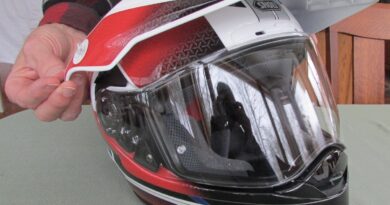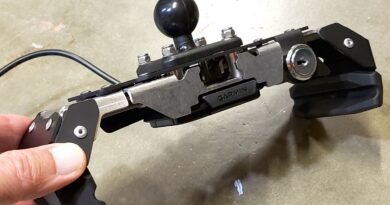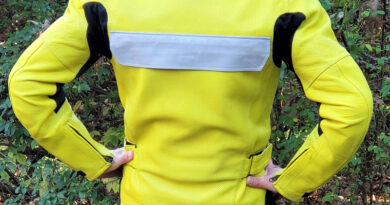Airbag vest shootout: Helite vs Klim
When I began riding, a good friend and MOA member gave me great advice: buy excellent protective gear and always wear it. So began my journey from ATGATT to ATGATS.
 A little more than two years ago, my son and I decided to try adding airbags to our gear. After a considerable amount of research, we both purchased Helite’s Turtle 2 Airbag Vest with a physical tether activation system with an easy to reset and reuse ability. Recently Klim and In&Motion teamed up to manufacture and distribute a tetherless airbag vest that can also be reset by the user. I bought one a couple of months ago, so now it is time to do a comparison review.
A little more than two years ago, my son and I decided to try adding airbags to our gear. After a considerable amount of research, we both purchased Helite’s Turtle 2 Airbag Vest with a physical tether activation system with an easy to reset and reuse ability. Recently Klim and In&Motion teamed up to manufacture and distribute a tetherless airbag vest that can also be reset by the user. I bought one a couple of months ago, so now it is time to do a comparison review.
Both systems provide excellent front and back torso coverage. They expand upward from the shoulders to help immobilize the helmet and protect the neck and collar bones. Both are reusable and negate the need for a back protector in your existing gear.
There is a lot to like about the Helite Turtle 2 Airbag Vest which is worn like a reflective vest over existing riding gear, and uses a tether between the vest and the motorcycle to trigger deployment.
The KLIM Ai-1 is the result of their partnership with In&Motion, the supplier of the brainbox for the airbag. This fact became obvious the day the products were delivered when the brain and the vest were delivered in two separate packages. The Klim Ai-1 is also very attractive and is worn as a vest under your existing riding gear. It is also a battery operated, fully self-contained with no sensors or tethers to attach to the bike.
Do they work?
No one ever wants to test these things out for real. Last summer, my son and I participated in Jim Ford’s Riders Workshop on the Appalachians’ hidden roads. There, my son managed to overcook a corner on his 2008 R 1200 GSA and went down at about 50 miles per hour while I was riding behind him. My son was wearing a Helite Turtle 2 Airbag Vest which deployed as expected, and when the dust settled, he was fine. While the broken parts of his motorcycle were fixable, we only had to replace the gas canister to reset the vest and had a spare ($30 each) on hand.
Before we got back on the bikes, Jim Ford asked my son how he felt, and my son pointed out that I (his dad) was more shaken than he was!
Comfort and Fit
 Neither airbag vest requires you to replace your favorite jacket, and just because you decide to switch over to a mesh jacket in the hotter months does not mean you give up the airbag protection. While the Helite is worn over your existing riding gear, the Klim Ai-1 is more stealthy, worn under your riding gear.
Neither airbag vest requires you to replace your favorite jacket, and just because you decide to switch over to a mesh jacket in the hotter months does not mean you give up the airbag protection. While the Helite is worn over your existing riding gear, the Klim Ai-1 is more stealthy, worn under your riding gear.
In my opinion, the stealth of the Klim Ai-1 offers a huge bonus, but it comes with two significant differences to the Helite. First, the Klim Ai-1 is designed to be snug to your body, and as a result, there is less airflow to your skin. I have worn the vest in 95-degree weather, and when moving with vents open, it is OK. The side mesh panels do allow plenty of airflow across the skin. On the other hand, I have worn the Helite above 110 degrees. Air flows readily over and around the Helite vest, so the existing jacket vents are not hugely affected, and you still get plenty of cooling airflow.
My impression so far is that the Klim Ai-1 is warmer than the Helite Turtle 2. The other significant difference is that there has to be enough room inside your gear to allow the Klim Ai-1 to deploy fully. This means that one-piece suits and attached pants may not be compatible. Fortunately, KLIM provides measuring guidelines to determine if you have enough space. Klim says that a properly fitted Hardanger one-piece suit has plenty of room for deployment. I wear an Aerostitch R3 which also has plenty of deployment room. The Helite has to fit over even the bulkiest winter riding gear and still be snug enough to do its job over summer gear. Fortunately, there is plenty of adjustability in the fit through the use of Velcro straps.
Changing Bikes
While changing jackets isn’t an issue, changing bikes might be. The Klim Ai-1 does not care what bike you are riding. On the other hand, the Helite requires that you either get a second tether or move your existing one. Additional tethers cost $29 from Helite. If there are multiple bikes in your stable, it is worth buying the additional tether since getting the length correct can take a few tries.
Crash Detection and Deployment
In the event you need them, both vests inflate almost instantly, covering your torso and stabilizing your neck by expanding up against the base of your helmet. The Klim deploys in 60 milliseconds while the Helite deploys in 75 milliseconds, a difference so small as to be almost meaningless. How the two systems detect a crash is where they differ. There is something reassuring about a physical trigger and as long as you remember to connect the tether, you know your airbag will deploy if you are violently separated from your bike. Speaking about about violence, walking away from the motorcycle while still tethered is nowhere near enough violence to deploy the airbag. Don’t ask me how I know. Let’s just say I have forgotten to untether more than a few times. Unfortunately, I have also forgotten to tether more than a few times as well.
There is something reassuring about auto-arming systems and forgetting to tether never happens with the Klim Ai-1. The vest can sit on a shelf powered on for up to 15 days. When it is not moving, the brain goes into a low-power standby mode, but wakes up and arms itself when you touch the vest. In this state, the battery lasts for 25 continuous hours of use. While information is sparse on the deployment sensors, my research leads me to understand that there are seven redundant sensors, including GPS, Bluetooth, and Wi-Fi. The remaining sensors are two, each accelerometer and gyroscopes. Any sensor can trigger the airbag to deploy once the algorithm decides. Therefore being in a tunnel without GPS will not render the airbag useless. Once the brain detects an unrecoverable fall or crash, the airbag fully inflates within 60 milliseconds. The Helite has only one sensor. Once a crash begins, the airbag must wait for all the slack to come out of the tether, and then it fully inflates within 75 milliseconds.
Then What?
Years ago, when we first decided to buy an airbag, the deciding factor in choosing the Helite was that the user could reset the airbag after a deployment. Dainese and Alpinestars both require the user to return their airbags to Italy for inspection and reset for a fee of $200 plus shipping. The Helite can be reset on the side of the road by replacing the $30 CO2 cartridge and takes less than five minutes.
The Klim Ai-1 can also be reset on the side of the road by the user and though the gas generator is a bit pricier at $99, the process is not any more or less complicated.
The Benefits of Technology
Early iterations of the In&Motion system included automatic notification of emergency personnel in the event of a crash when the rider was not moving within three minutes. While that feature does not seem to be enabled at this time, the software and the detection algorithms are continually evolving, and your vest automatically updates to the latest software. Ride data and crash data are also continuously and anonymously collected and evaluated to improve the triggering algorithm with regular updates sent back to the vest. This means the best possible detection and deployment algorithms are always up to date on your Klim Ai-1. On the other hand, electronics and water don’t often get along well. The Helite Turtle 2 is oblivious to water, but the Klim Ai-1 must remain protected under your riding gear and rain gear.
Ready to Buy?
The Helite Turtle 2 Airbag Vest can be purchased online for $659 and comes with a one year warranty. While the purchase of the Helite Turtle 2 is straightforward, the Klim Ai-1 has a few twists and turns. First, you are purchasing the vest from Klim for $399. Klim warranties their products for the “practical lifetime of the product.” Upon purchase, you also receive the In&Motion Brainbox which is disabled until you either buy or lease it from In&Motion. I have overheard many conversations about this, and the leasing concept seems to be somewhat off-putting to many customers. If you purchase the In&Motion brainbox for $399, your total cost is $798 (for comparison, Alpinestars and Dainese offerings are each $700). When you own the brain, you get all the updates, but the warranty is only valid for two years. A warranty is processed by sending the brain in for repair. If, on the other hand, you decide to lease the brainbox for $12 a month or $120 a year, In&Motion sends out a replacement whenever needed, and then you send the old one back.
As I write this, winter has set in for many of us, and bikes are hibernating. If you choose the monthly lease option, you can suspend your service for the non-riding months. After three years, you get to upgrade to the newest brainbox. Leasing is the most cost-effective option in the short term, but after 39 months of continuous leasing, the cost basis for the two options is equal. I chose the lease option for the unlimited warranty and the upgrades.
What Do I Recommend?:
I recommend ATGATS: All The Gear And Then Some.
Now that Airbags are readily available and multiple companies are competing to make the best product, I recommend that everyone add them to their kit. Whether you choose Klim, Helite, Point2, HitAir, Dainese, or Alpinestars, you can’t go wrong. If you are cost-conscious, select one of the tethered systems. If you are brand loyal, choose your favorite brand. If you believe in technology and always want the most up to date crash detection algorithms, choose In&Motion and one of their partners such as Klim. Me? I am selling my Helite Turtle 2 and keeping the Klim Ai-1
| Helite’s Turtle 2 | KLIM’s Ai-1 Airbag Vest | |
| Cost | $659 | Buy: $399 + $399 = $898
Lease: $399 + $12 /month or $120 /year |
| Warranty | 1 year | Buy: 2 years / Lease: Unlimited |
| Certifications | CE Certified | CE and SRA Certified |
| Trigger | tether | 7 redundant sensors |
| Reset | $30 and 5 minutes | $100 and 5 minutes |
| Airflow | Slightly affected | affected |
| Versatility | Excellent limited to bike | Excellent limited to jacket space |
| Looks | Show-off | Stealth |
| Drawbacks | Forget to tether | May not fit under all riding gear |




I wish there was some scientific testing done on inflatables regarding how well they protect the neck. Prior to purchasing/owning my Helite Turtle my wife and I always word Leatt neck braces. It amazes me how the majority of the motorcycling community considers a helmet an essential part of atgatt and completely ignore protecting their neck.
Would have been nice to include the Hit-Air and other vests out there. Covering only those 2 vests gives short shrift to your readers in trying to evaluate the choices for air vest manufactured. Been wearing a Hit-Air MLV for 3+ years and very pleased….
David – please submit a review of your gear. Just because these are the only 2 covered so far doesn’t mean we don’t want to know about more options. We look forward to hearing from you – please send to [email protected]. Thanks!